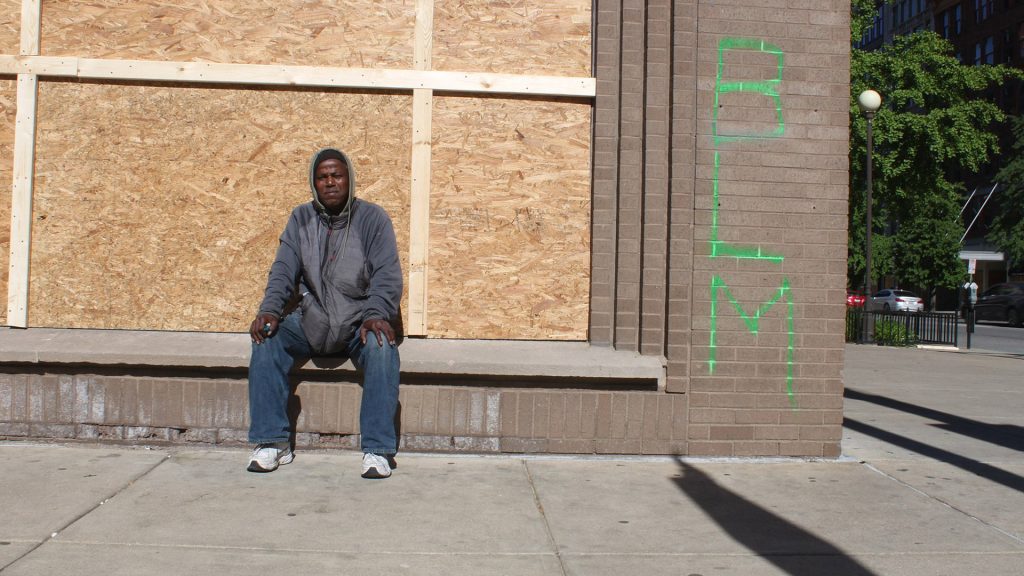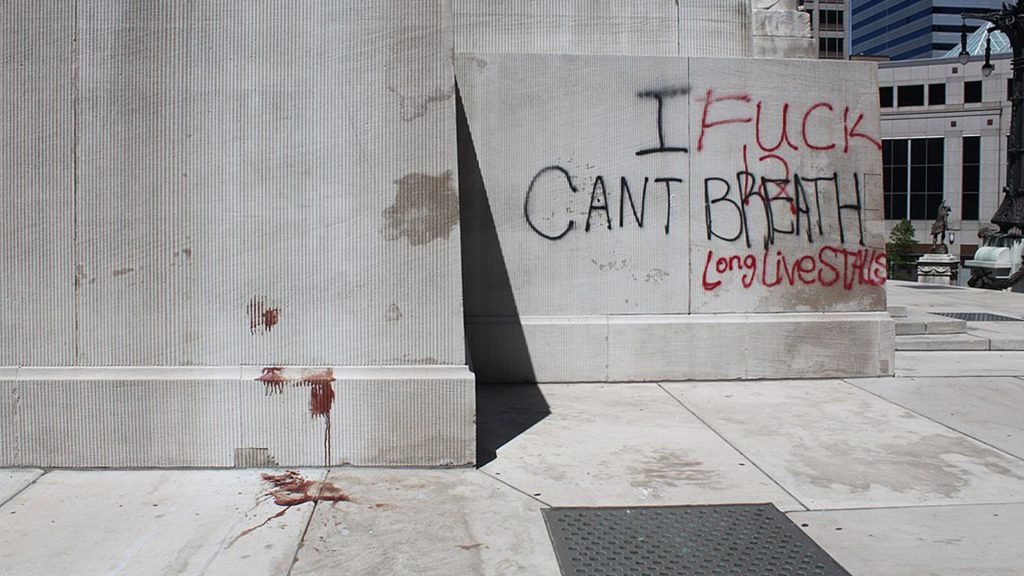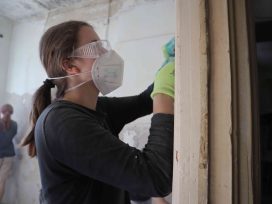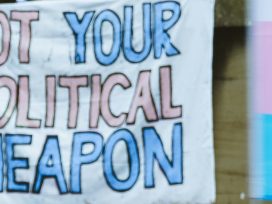In 1844, James Russell Lowell penned the anti-slavery poem ‘The Present Crisis’ in response to the political tumult leading up to the Civil War. Inspired by Lowell’s poem, the National Association for the Advancement of Colored People (NAACP) called its official magazine The Crisis, with W. E. B. Du Bois as its founding editor. The first issue appeared in 1910. Since then, The Crisis has been continuously published – because the crisis it has chronicled for over one hundred years has ebbed and flowed, but never subsided.
Now, at the beginning of the third decade of the twenty-first century, hundreds of thousands of people are in the streets in all 50 states and in cities around the world, while governing institutions flail, in malice or studied ignorance, about what is to be done to address its latest iteration.
But the problems are not new. The crisis, as ever, is white supremacy. The crisis is racial capitalism. The crisis is the debilitating misogyny of patriarchy and its economic, political, and social effects. The crisis is that most people around the world are prevented from living in their full dignity.

Indianapolis 1 June 2020. Photo by NotSoAngryAnymore (Reddit Username) on Wikimedia Commons
People protesting in the streets are disrupting business as usual in defence of Black lives and the stakes are higher than you think. The battle in the streets is for the authority to set the terms of life in the twenty-first century. We are living in a world-historical moment.
What we know is that for the last seven years we have been bombarded with videos of Black people being murdered by police and vigilantes, while governing authorities have urged calm as they have done nothing to rectify the injustices that keep bringing us back to this furious grief. So, this time there is no calm to be found. A multi-racial coalition of people led by Black organizers is demanding action and vowing that without justice, there will be no peace.
What must be understood is that protest is not only an expressive function of those who have been too long abused, it is a specifically political tactic meant to call unresponsive decision-makers to surrender power – or find the courage to serve their constituents. Protest is one way a democratic people asserts its legitimate power – and it’s also a reminder that a people can refuse to be governed – by revoking their consent.
So, it is inappropriate to begin this political conversation from the perspective of the governors who have failed to respond to the cries of Black people who have been insisting for generations that they cannot breathe under the knee of structural racism. Instead, we must begin with the demands of those who have massed in the street and declared that they will no longer be ignored.
Let us be clear:
No honest appeal can be made for the de-escalation of the tactics of protestors when the police who have murdered George Floyd have only been arrested and charged due to the passion and persistence of people in the streets.
No honest appeal can be made when the killers of Breonna Taylor, Tony McDade, David McAtee, and countless others remain free to go about their lives.
No honest appeal for de-escalation of the tactics of protestors when governors are instituting curfews to curb the speech of citizens.
No honest appeal can be made under the glare of police in riot-gear, staring malevolently from tanks and wielding weapons of war.
No honest appeal can be made for de-escalation when the current occupant of the White House has vowed to use the military to quell dissent.
Appeals made under these conditions have been rightly judged dishonest.
And so, each day more people come to the streets with signs that can double as shields against rubber bullets, tear-gas canisters, and flash-bang grenades.
‘No justice, no peace’ is a refrain oft-heard at protests, but there has rarely been a time when people were in a position to actually enforce that declaration. Although the present crisis is an iteration and extension of the calamity at the centre of the construction of the western world – the European trans-Atlantic trade in chattel slaves from Africa to the Americas – it comes to us under unique circumstances.
The pandemic that has ravaged the US population, disproportionately killing Black and Native peoples. It has left 40 million people unemployed, with Black people and women bearing the brunt of the losses. At the same time, it has forced millions of people to work from home – and this has given people the flexibility to engage in civic action in a way the normal economy of late-capitalism has usually denied.
Twitter user Bittani Nichols puts the matter succinctly:
I don’t know who they think they’re scaring with this ‘curfew will stop when the protests do.’ We ain’t got shit else to do. This is my job now. I’ll make the whole city a schedule like… you protest Monday to Thursday [and] if you can’t make it find someone to cover your shift.
Therefore, there will be no peace until our governors stops using military tactics and do what the elected leaders in a functioning democracy ought to do: listen to, and act on, the demands of the people.
If you are paying attention, the immediate demands are clear:
– Arrest and charge the police who murdered George Floyd, Breonna Taylor, Tony McDade, David McAtee, and other victims of police execution whose names are not yet nationally known.
– Keep the police away from the protests. If they come, do not send them in riot gear or with military weapons.
But this moment is bigger than these immediate demands. Due to the work of the Movement for Black Lives (M4BL), an umbrella organization that consists of a coalition of movement organizations across the nation, over the last seven years, people are able to connect the dots between the symptoms of the present crisis and their structural causes.
Political scientists have generally given social movements too little credit for their role in democracy. What ought to have become clear in the protest cycle that has characterized this century, from Occupy Wall Street forward, is that protest is not only an expressive activity, it is a specific and essential political tactic that can change the way people understand reality. Protests that are connected to clear and resonant messages are not one-off events. As I showed in my book The Politics of Common Sense, resonant messages from political challengers furnish people with an alternate explanation of how things are and ought to be. If resonant messages persist over time, they begin to shape the way we encounter the world, even for people who do not (yet) agree.
But there is more. Protest is not only a political tactic. It is a learning experience for both those involved and those observing. The present uprising is not a replay of any other. This is not 1968, or 2014. Each iteration of struggle in the streets teaches the organizers galvanizing people’s consciousness, the activists showing up at actions, and the observers trying to figure out what is going on. What they learn is more about the principles at stake, where they stand, and what they are willing to do to create the change they seek.
That means that protest creates political possibilities that did not exist before it and could not exist without it. In this way, social movements radicalize politics as they educate the polity. It is for this reason that we have to understand social movement as cumulative. The people massing in the streets today are not merely a heartbroken mob. They have had the years since 2014 to consider the stakes. History is not a series of discrete snapshots, it is a diachronic process – injustices compound, but we also learn.

Indianapolis 1 June 2020. Photo by NotSoAngryAnymore (Reddit Username) on Wikimedia Commons
Those of us in the streets have learned that escalation is appropriate when previous, more mild tactics have not worked. People who were confused about what Black Lives Matter means or about what the Movement for Black Lives wanted have had plenty of time to catch up. Many have learned from the multi-platform discourse spurred on by the Movement for Black Lives, they have learned what to think of events, where they might fit in, and how they might act. They know what side they’re on.
They have learned, also, that the police can and do lie, that they can and do assault people without cause, that they can and do murder people without cause.
The movement has done the work necessary to earn what I have written about as political acceptance. Political acceptance is not synonymous with agreement and does not mean the problem has been resolved. Instead, political acceptance is a threshold condition that marks a set of issues as urgent and necessary to address. Political acceptance means that political challengers no longer have to argue about whether their cause is a political problem; everyone accepts that it is, and they can focus instead on arguing about how to solve it.
Because of the passionate protest that the world witnessed in Ferguson and cities around the country in 2014, the clear and often contentious communication about why those protests were happening, and the organizations that were born to combat structural racism in the wake of that moment, no one can now deny the reality of systemic, racist police violence. So much about how people understand the task before us has changed. In 2015, Black Lives Matter was a contentious slogan. Just five years ago, the pull of ‘colour-blindness’ and ‘tolerance’ as dominant ideologies made the slogan centring the suffering of Black people seem gauche, even offensive. Afterall, it was less than four years ago when San Francisco 49ers quarterback Colin Kaepernick was pushed off his team and out of the NFL for insisting that America recognize the ongoing violent oppression of Black people.
While activists do well to call out the often vague and hollow statements of corporations and other entities that are now tweeting messages of support or gesturing toward fighting injustice, we must also recognize that these gestures represent a transformation of the political context. Through the relentless campaign by the Movement for Black Lives to give Black people the language to talk about the structural depth and breadth of anti-Blackness and to educate all people about its reality, the movement has changed common sense.
We see evidence in the transformation of the public opinion environment on issues of race, racism, and policing. Since the Ferguson uprising after the police killing of Michael Brown, M4BL has influenced opinion about the significance of race and racism in American life, changed policy, contributed to the reduction of police violence in major cities, and reshaped the politics of social justice.
The share of Americans who say race is a big problem almost doubled between 2011 (28 percent) and 2015 (50 percent), with the trend in worrying more about race and racism continuing on a sharp upward trend to the present day, with 64 percent of Americans declaring racism a major problem. In 2014, 46 percent of Americans believed that we need to keep making changes to achieve racial equality; by 2017, that number had increased to 61 percent. The most dramatic change has been among white Americans, particularly white liberals and/or those who identify as Democrats. Between 2009 and 2015, the year when BLM protest was most frequent, the share of white Democrats declaring racism a ‘major problem’ increased from 32 percent to 58 percent and climbing to 76 percent by 2017, almost matching the concern of Black Americans (81 percent) for the first time.
For the first time, the majority of whites believe that Black people are treated less fairly by police and the judicial system. Surprisingly, reported racial resentment toward Black people has been decreasing among whites, in general. Data from a panel study conducted between 2008 and 2018 showed that anti-Black prejudice has been declining since 2014, with a sharp decline in reported belief in anti-Black stereotypes among whites, from an average score of 8.1 to an average of 5.4, regardless of party between 2016 and 2018. More provocatively, whites in counties where M4BL groups held protests have average scores on racial resentment measures that decreased significantly more than those of whites in counties where no protest took place. In counties where protests took place, the Democratic Party’s share of the vote increased on average 4–6 percentage points.
Polling that has come out since the uprising began has only underscored this shift. A Morning Consult poll released on 2 June reports that 58 percent of respondents view discrimination against Black people as one of the ‘biggest problems facing America today’ and 54 percent of Americans support the ongoing uprising. All of this evidence points to the fact that a ‘law and order’ playbook is not going to work for the 45th president or any governor who tries to copy it. This is not a re-run, this is something new.
As journalist Wesley Lowrey wrote, ‘The reason this feels different is not that the police behaviour is different – it’s that more … people, specifically white people, are willing to believe the truth than even just a few years ago.’
As a result, a lot more people today have an inkling about what it will take to create a world where Black people can live and thrive. Thanks to the education provided by the Movement for Black Lives, people are coming to understand that nothing less than a radical political transformation will do. This creation of new political possibilities is the most sacred democratic good of social movements – they can change not only policy but the practice of politics itself.
Consider one of the movement’s most radical demands: to defund the police and redirect the money to what Patrisse Cullors, co-founder of Black Lives Matter Global Network, has called an ‘economy of care’, rather than an economy of punishment. A demand that might have seemed outlandish a month ago no longer seems so far-fetched.
Take the case of Minneapolis. In the past, Minneapolis politicians who tried to cut the budget of the police faced slowdowns in their wards, as Steve Fletcher, a state representative, explains:
After the first time I cut money from the proposed police budget, I had an uptick in calls taking forever to get a response, and MPD officers telling business owners to call their councilman about why it took so long. We pay dearly for public safety: $195 million a year plus extensive, expensive legal settlement. That should buy us more than a protection racket … That is what people in the streets have now changed … It became clear by day two that people were marching for much more than any prosecution could offer. What people in the streets have won is a permanent, generational change to the mainstream view of policing.
In a 30 May editorial in the New York Times, movement strategists Phillip and Thenjiwe McHarris wrote:
The only way we’re going to stop these endless cycles of police violence is by creating alternatives to policing. Because even in a pandemic where black people have been disproportionately killed by the coronavirus, the police are still murdering us … The solution to ending police violence and cultivating a safer country lies in reducing the power of the police and their contact with the public. We can do that by reinvesting the $100 billion spent on policing nationwide in alternative emergency response programs.
The University of Minnesota and Minnesota Public Schools are taking this advice, which local organizers have been calling for since the Ferguson uprising, by ending their contracts with the Minneapolis Police Department. There are widespread campaigns pressuring other institutions to follow their lead. Even more shocking, Los Angeles mayor Eric Garcetti announced that the city will cut 100–150 million dollars from the police budget, with those funds to be reinvested in communities of colour.
In addition, Justin Amash, a former Republican, now Libertarian representative from Michigan, has introduced a bill with Ayanna Pressley (D, MA) that would end ‘qualified immunity’ for police officers accused of misconduct, allowing victims to sue them personally. Senators Brian Schatz (D, HI) and Rand Paul (R, KY) have introduced legislation to ban the transfer of military-grade weapons to local police departments.
This call to centre care, as I show in my forthcoming book Black Lives Matter and the Democratic Necessity of Social Movements, is crucial to the political philosophy of the Movement for Black Lives and is a part of what has made its demands so resonant. The soaring economic inequality that has been growing malignantly since 1980 has already changed most people’s lives such that they cannot care for themselves and their families in humane ways. The frantic cultural clamour for ‘work-life balance’, ‘wellness’, ‘mindfulness’, and the desperate search after how to ‘have it all’ – all exhortations that fall disproportionately on women – are sad and inadequate trends that try to ‘empower’ people to personally overcome the structural desolation of their interior and domestic lives. Poor and working-class people, along with others at all income levels who make their money from wages rather than capital investments, have seen their pay stagnate as their hours expand along with the expectation that they should gratefully accept the colonization of their entire lives by waged work.
The seeming overnight popularization of Audre Lorde’s declaration that ‘Caring for myself is not self-indulgence, it is self-preservation, and that is an act of political warfare’, which movement actors circulated online in 2014, is no accident. Though the notion of ‘self-care’ has now been commodified and is often taken out of the intended context of political action, the hunger for time, space, and resources to care for ourselves, our loved ones, our polities, and the earth is a real and ravenous need.
All of this is only underscored by the reality of the COVID-19 pandemic in which Americans have, for the most part, been left to fend for themselves. The pandemic has laid bare to all what some already knew – we have been living with a paucity of leadership in government, combined with the growing power of avaricious capitalists who put profit over people every time.
All of these circumstances of revelation have created a confluence of political energy that has been bolstered by the radical imagination and fearless action of M4BL and allied movements. It has been a long-time in the making, but our moment has come. This is our opportunity to choose and shape a new era. And we know that birth is always a crucible. The question before us is: what kind of society will we usher into existence?
4 June 2020








